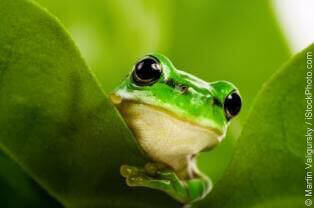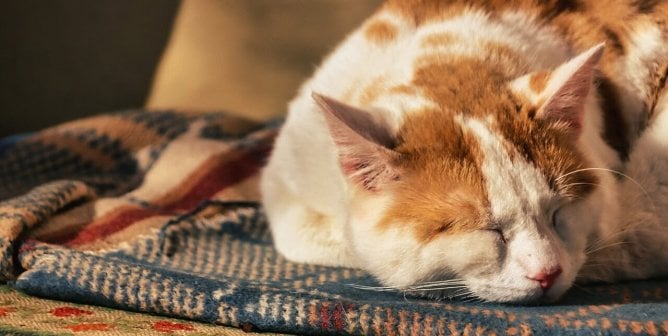When heading to the mall this year for your holiday shopping, chances are you’ll walk by a Brookstone store. With a couple of massage chairs set out in front, you might think that this gadgety retailer takes the comfort and the well-being of others seriously.
With so many gadgets aimed toward human relaxation, we were surprised to learn about Brookstone’s “Frog-O-Spheres” (aka tiny aquatic prisons), which seem to encourage purchasers to keep a frog in a tiny clear plastic box on their bookshelf. The Frog-O-Sphere fails as a representation of an African dwarf frog’s natural habitat.
As you can see from the care sheet below, these frogs are complex little animals who in the wild, would be exploring terrain consisting of dense aquatic vegetation and stones—not your desktop.
In November 2009, PETA went undercover at Wild Creations, the company that supplies “Frog-O-Spheres” to Brookstone. PETA’s investigator documented the rampant neglect and mishandling of African dwarf frogs and total disregard for their needs, welfare, and lives. Read more about what PETA’s investigator found. Thanks to the calls and e-mails from compassionate people, Brookstone agreed to remove the once-included snails from its Frog-O-Spheres—now if it would just stop including frogs! Please take a moment to write to Brookstone and ask that it stop imprisoning frogs. And if you find yourself dragged into a Brookstone with others while shopping, don’t hesitate to politely let the manager know that you don’t approve of the store’s actions.
Caring for African Dwarf Frogs
African dwarf frogs are social, aquatic animals who live in the warm rivers and streams of central Africa, hiding and laying their eggs in between rocks and under plants. Tens of thousands of these complex animals are bred in cruel conditions for the pet trade, which sells them in tiny plastic cubes as “low-maintenance decorations.” People who buy these frogs on a whim often have no idea how to look after them and are misled into believing that they require little care. African dwarf frogs are tiny, but they require specialized care and a lifetime commitment.
Many frogs have suffered and died because of inadequate housing and care. As veterinarian Mike McGuill points out, “Frogs have particular environmental needs …. ‘Low-maintenance’ is a myth.”
PETA urges people not to buy these frogs or any animal from a pet store. If you already have an African dwarf frog, you can make your frog’s life as comfortable as possible by following this information.
Housing
The tiny plastic cubes in which African dwarf frogs are often confined are completely inadequate for their needs. According to amphibian expert Dr. Phil Bishop, “In the wild these frogs would … normally seek shelter away from the light under stones or logs or other debris in the ponds and streams which they inhabit. … [T]hese Frog-O-Spheres are unacceptable in failing to meet the basic requirements for good animal husbandry.” Frogs need at least 10 gallons of water in a 2- to 3-foot deep tank that is covered with a lid for safety. Fill the tank with plain, clean unchlorinated spring water. If you are using tap water, use a water conditioner or let the water stand for 24 to 48 hours to allow the chlorine to evaporate before filling the tank. Change the water weekly or use a high-quality, nonvibrating filter. Include live aquatic plants in the tank to give the frogs places to hide and explore. Never release these frogs into the wild. According to Mark Berman of the Earth Island Institute, “Invasions by non-indigenous species are among one of the most severe threats to waterways around the country. … If these animals are released into the wild, it will certainly lead to drastic changes in the ecology of marine, estuarine, and freshwater systems.”
Feeding
African dwarf frogs must be fed at least once daily, especially juveniles (instructions that come with these frogs incorrectly claim that frogs only need to be fed twice weekly). Feed the frogs only enough to cause their stomachs to bulge slightly. The frogs’ stomachs are located near the middle of their left sides on their underbellies. Since African dwarf frogs are carnivorous bottom feeders, they rarely eat at the surface. Use only sinking frog and toad bites—never feed them fish flakes, hard food pellets, or freeze-dried foods, as they can cause malnutrition or deadly intestinal blockages. Frogs’ diets can be supplemented with frozen bloodworms, frozen brine shrimp, or live black worms. Just be sure to thaw frozen worms and shrimp in a small amount of the tank water.
Illnesses and Veterinary Care
Healthy African dwarf frogs are very active, especially at night, since they are nocturnal. Like all animal companions, African dwarf frogs require regular check-ups and prompt attention if they become ill. If you notice any of the following symptoms, rush your frog to a veterinarian:
• Bacterial infections can cause cloudy eyes, open sores, and reddened skin.
• Chytrid fungus attacks frogs’ skin, making it difficult for them to breathe and damaging their nervous systems. Symptoms include discolored skin, peeling skin (especially around the feet), rough skin, frogs sitting out in the open, sluggishness and lack of appetite, and frogs keeping their legs spread away from the body instead of tucking them in. In extreme cases, the frog’s body will be rigid, and his or her back legs will trail behind.
• Dropsy is severe bloating caused by kidney failure or by poor water conditions with subsequent bacterial infection. There is no known effective treatment for dropsy. If your frog develops dropsy, immediately check the tank water’s pH, ammonia, nitrate, nitrite, and temperature and perform any water changes that are required.







